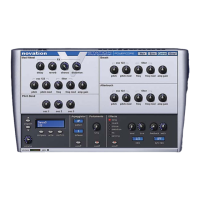LFOs Extras
To illustrate this, assume the LFO waveform is a triangle wave and at a specific moment in time
all eight are at the beginning of a the rising portion of the wave. At a later point in time all will be
at the beginning of the falling portion of the wave. If this waveform is applied to pitch, when a
number of notes are played simultaneously, the pitch of all the notes will rise and fall at
precisely the same time.
If the LFO is not locked, then each wave will be at a random position relative to the others. In
this pitch modulation example, the pitch of all the notes will be changing ‘out of
synchronisation’ with others.
Imagine a string section of eight violin players. Here are eight people, each playing their
instruments individually - they will play in time but their bowing and vibrato is going to be un-
synchronised, with each player going at ever so slightly different rates and also, as one player’s
vibrato may be rising, another’s is falling. It is this that gives an orchestral string section its lush,
rich sound. With the LFO locked and the LFO being used to create a vibrato, all eight of the
string players would have the bow in exactly the same position, would be performing their
vibrato at exactly the same rate and phase, etc.. This obviously does not occur in a real string
section and if it did, the sound would be very rigid and mechanical - in fact, it may as well be
played by robots! In reality, each player’s bow would be in a slightly different position and each
player’s vibrato would be slightly different which gives the strings a ‘chorus’ type sound. To
simulate the string section (and to create lush pads, etc.), the LFOs should not be locked.
Setting this to ON will ‘lock’ the LFO.
SYNC RATE menu
Both LFOs may be synchronised to MIDI Clock. As an example, a very pleasing audio effect
may be achieved when an LFO is modulating the filter cutoff frequency and is in perfect sync
with your sequencer’s tempo - the sequencer opens and closes in time with the music.
To synchronise an LFO, alter this value until the desired musical timing is displayed. See the
synchronisation table below for details on how these settings relate to the MIDI Clock:
OFF
32nd T
32nd
16th T
16th
8th T
16th D
8th
4th T
8th D
4th
2nd T
4th D
2nd
1bar T
2nd D
1bar
2bar T
-
2
3
4
6
8
9
12
16
18
24
32
36
48
64
72
96
128
Manual rate
32nd Triplet
32nd
16th Triplet
16th
8th Triplet
16th Dotted
8th
4th Triplet
8th Dotted
4th
2nd Triplet
4th Dotted
2nd
1 Bar Triplet
2nd Dotted
1 Bar
2 Bars Triplet
Menu Item MIDI Clocks Synchronised to
1bar D
2bars
4bar T
3Bars
5bar T
4bars
3bar D
7bar T
5bars
8bar T
6bars
7bars
5bar D
8bars
9bars
7bar D
12bars
144
192
256
288
320
384
432
448
480
512
576
672
720
768
864
1008
1152
1.5 Bars
2 Bars
4 Bar Triplet
3 Bars
5 Bar Triplet
4 Bars
4.5 Bars
7 Bar Triplet
5 Bars
8 Bar Triplet
6 Bars
7 Bars
7.5 Bars
8 Bars
9 Bars
10.5 Bars
12 Bars
Menu Item MIDI Clocks Synchronised to
Be aware that if an LFO is synchronised to the MIDI Clock, the MAIN panel’s LFO SPEED knob
will have no effect on the LFO speed. The actual speed of the LFO will be determined instead
by the tempo of the MIDI Clock signals being transmitted by a sequencer. Many sequencers do
not transmit MIDI Clock messages at all when they are stopped.
Setting this function to OFF allows the LFO to run at its own speed, which can be controlled by
setting the LFO SPEED knob, found on the MAIN panel
66 CONTROLS panel / Operation

